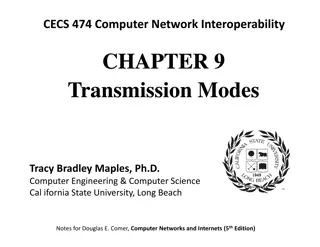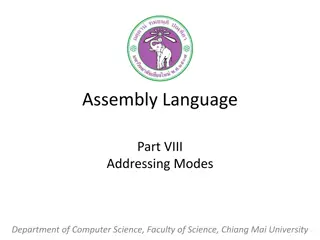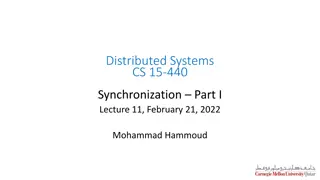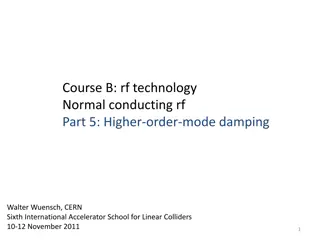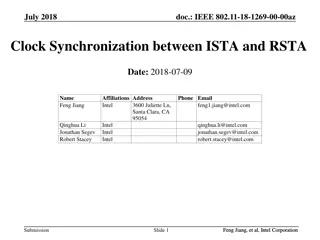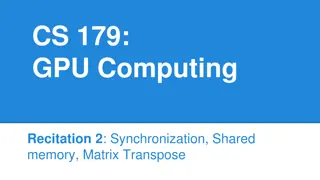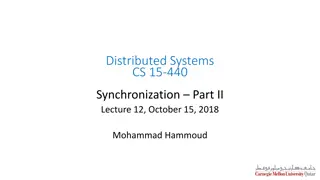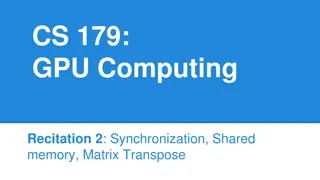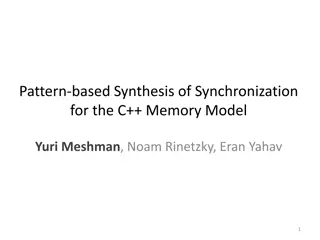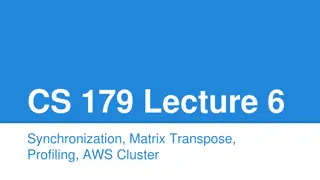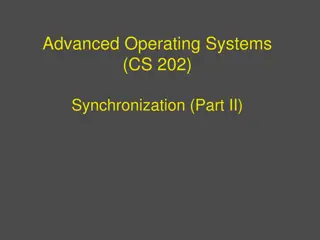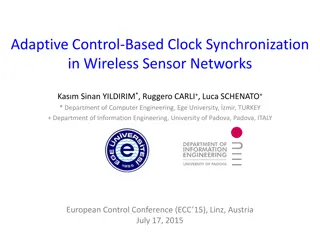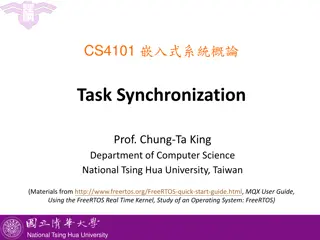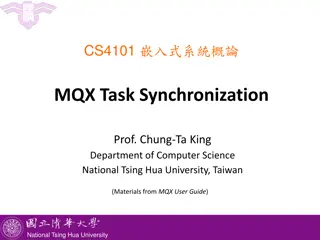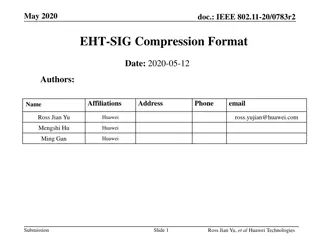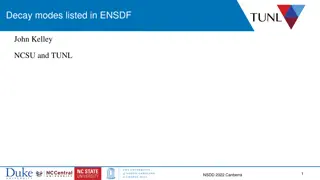Transmission Modes in Computer Networks
Transmission modes in computer networks can be divided into serial and parallel modes. Parallel transmission allows multiple bits to be sent simultaneously over separate media, while serial transmission sends one bit at a time. The choice between serial and parallel transmission depends on factors s
3 views • 13 slides
Addressing Modes in Assembly Language
This content delves into the intricacies of addressing modes in assembly language, covering topics such as one-dimensional arrays, the DUP operator for defining arrays, and various modes like register, immediate, direct, and register-indirect modes. It explains how operands are specified in differen
6 views • 24 slides
Addressing Modes in 8051 Microcontroller
Addressing modes in the 8051 microcontroller play a crucial role in specifying how data is accessed and operated by instructions. They include register addressing, direct addressing, register indirect addressing, immediate addressing, and indexed addressing modes. Each mode offers unique ways to han
12 views • 20 slides
Synchronization in Distributed Systems: Examples and Taxonomy
Understanding the need for synchronization in distributed systems is vital for ensuring correct operation. Examples such as vehicle tracking and file writing highlight the importance of entities coordinating and agreeing on events and resource access. A broad taxonomy of synchronization reasons is d
6 views • 31 slides
Managing Higher-order Modes in Normal Conducting RF Technology
The excitation of higher-order transverse modes due to misalignments between the beam and RF structures can lead to beam instability in linear colliders. This instability can be mitigated by selectively damping the transverse modes and/or detuning the dipole mode frequencies. Understanding the diffe
3 views • 34 slides
Efficient Support for Synchronization Without Invalidations
Addressing complex software issues like data races and inefficiencies in hardware synchronization, the DeNovoSync solution provides efficient support for arbitrary synchronization without writer-initiated invalidations. By introducing disciplined shared memory with structured synchronization and exp
3 views • 40 slides
Time, Clock Synchronization, and Atomic Clocks
Delve into the intricacies of time and clock synchronization, from the rotation of the Earth to atomic clock standards. Explore the importance of physical clock synchronization and the practical implications on technologies like GPS. Uncover the terminology and methodologies involved in achieving pr
15 views • 24 slides
Modes in Data Analysis
Explore the concept of modes in data analysis through examples like ice-cream sales and mathematical connections to fashion. Learn about unimodal, bimodal, and multimodal datasets and how to identify modes effectively. Discover the significance of modes in making decisions and solving real-world pro
3 views • 9 slides
IEEE 802.11-18-1269-00-00az Clock Synchronization Investigation
In July 2018, a document was presented by Feng Jiang et al. from Intel Corporation focusing on clock synchronization between ISTA and RSTA in IEEE 802.11-18-1269-00-00az standard. The document delves into the impact of sampling clock errors on range estimation, carrier frequency synchronization in 1
5 views • 10 slides
GPU Computing and Synchronization Techniques
Synchronization in GPU computing is crucial for managing shared resources and coordinating parallel tasks efficiently. Techniques such as __syncthreads() and atomic instructions help ensure data integrity and avoid race conditions in parallel algorithms. Examples requiring synchronization include Pa
4 views • 22 slides
Distributed System Synchronization and Logical Clocks
Continuing from the previous lecture on time synchronization, this session delved into logical clock synchronization, mutual exclusion, and election algorithms in distributed systems. Logical clocks, such as Lamport's Clock and Vector Clock, play a crucial role in defining the order of events withou
2 views • 33 slides
Principles of Operating Systems Synchronization Mechanisms
Operating systems utilize high-level synchronization mechanisms such as semaphores, condition variables, and monitors to provide synchronization beyond mutual exclusion. Semaphores are abstract data types that offer mutual exclusion to critical sections, while condition variables model uncounted eve
3 views • 21 slides
The Time Cost Distance Model
The Time Cost Distance Model in Transit Corridors aims to illustrate the cost and time aspects of door-to-door movement along available routes and modes within a transit transport corridor while highlighting delays at borders or inspection points. The model proposes a methodology based on cost and t
1 views • 14 slides
Synchronization and Shared Memory in GPU Computing
Synchronization and shared memory play vital roles in optimizing parallelism in GPU computing. __syncthreads() enables thread synchronization within blocks, while atomic instructions ensure serialized access to shared resources. Examples like Parallel BFS and summing numbers highlight the need for s
5 views • 21 slides
Pattern-Based Synthesis of Synchronization for C++ Memory Model
Examining the pattern-based synthesis of synchronization for the C++ memory model, this study delves into concepts like Dekker's Algorithm and achieving mutual exclusion in parallel programming. It discusses the automatic inference of efficient and correct synchronization under the C++ memory model,
4 views • 27 slides
Parallelism and Synchronization in CUDA Programming
In this lecture on CS.179, the focus is on parallelism, synchronization, matrix transpose, profiling, and using AWS clusters in CUDA programming. The content delves into ideal cases for parallelism, synchronization examples, atomic instructions, and warp-synchronous programming in GPU computing. It
6 views • 29 slides
Concurrency Sources and Pitfalls in Scull: Understanding Synchronization
Sources of concurrency in advanced operating systems, synchronization pitfalls in Scull, memory leaks, and synchronization primitives like locks and mutexes are discussed in this content of CS 202. Learn about race conditions, protecting shared variables, and different synchronization techniques.
2 views • 25 slides
Synchronization and Scaling Challenges
Study the impact of synchronization on scaling, exploring hardware artifacts and higher-level primitives. Learn how synchronization ensures coordination, the hindrance to scalability, and the overheads that arise. Understand basic hardware artifacts like CAS, TAS, FAI, and synchronization primitives
5 views • 53 slides
Decentralized Dataset State Synchronization in Named Data Networking
Synchronization plays a vital role in various applications such as file sharing, group text messaging, and collaborative editing. This paper introduces ChronoSync, a decentralized dataset state synchronization protocol based on Named Data Networking (NDN). Learn about NDN architecture, ChronoSync de
1 views • 17 slides
Adaptive Control-Based Clock Synchronization in Wireless Sensor Networks
This study focuses on the implementation of adaptive control-based clock synchronization in wireless sensor networks to achieve precise time coordination among sensor nodes. It discusses the challenges, proposed solutions, hardware clock details, need for synchronization, and time synchronization me
2 views • 20 slides
Exploring Embedded Systems Department of ECE and ARM Serial Parallel Communication
Discover the world of Embedded Systems at the Department of ECE, created by Dr. Ravinder Nath Rajotiya at JIMS Engineering Management Technical Campus. Dive into topics like ARM Serial Parallel Communication, Communication Protocols, Transmission Modes, Clock Synchronization, and more. Learn about S
12 views • 9 slides
8051 Microcontroller Addressing Modes Overview
Learn about the different types of addressing modes in the 8051 microcontroller, such as Register, Direct, Register Indirect, Immediate, and Indexed addressing modes. Understand how these modes work and their significance in improving CPU processing speed and efficiency.
2 views • 20 slides
IEEE 1588 Based Synchronization Distribution System Implementation
Explore the practical implementation and challenges of an IEEE 1588 based synchronization distribution system in network elements. Learn about T-BC ToD synchronization, Telecom Boundary Clock functionality, and goals of network synchronization.
1 views • 14 slides
Member Synchronization and Data Management Solutions
Explore a range of solutions for member synchronization, data management, and identification process optimization. From resolving missing member data issues to implementing effective synchronization settings, enhance your operations with advanced tools and strategies. Discover the reasons behind del
1 views • 14 slides
Self-Organized Inter-Destination Multimedia Synchronization for Adaptive Media Streaming
Explore the innovative concept of Inter-Destination Multimedia Synchronization (IDMS) for adaptive media streaming, addressing challenges and detailing the architecture with session management and synchronization approaches. Learn about the synchronization points and strategies for seamless playback
2 views • 14 slides
Operating System Synchronization Principles
Explore the critical-section problem, solutions for shared data consistency, classic synchronization problems, and tools used for process synchronization in operating systems. Discover software and hardware solutions, synchronization examples, and alternative approaches.
2 views • 47 slides
Task Synchronization in FreeRTOS: Overview and Mechanisms
Explore the importance of task synchronization in FreeRTOS, including mutual exclusion, control flow, and data flow synchronization. Learn about synchronization mechanisms like queues, semaphores, and mutexes for efficient resource management in real-time operating systems.
0 views • 32 slides
Task Synchronization Strategies in MQX: Mutual Exclusion, Control Flow, and Data Flow
Explore the importance of synchronization in managing concurrent tasks, covering mutual exclusion, control flow, and data flow synchronization strategies within MQX. Understand the use of semaphores, mutexes, events, and more to address synchronization challenges effectively.
3 views • 46 slides
Operating System Synchronization Concepts with Semaphores and Locks
Explore the principles of operating systems synchronization through semaphores and locks, focusing on effective resource access, performance optimization, and the historical perspective of semaphores. Learn about the importance of locks, basic locking operations, and the theoretical soundness of sem
4 views • 52 slides
IEEE 802.11-20/0783r2 EHT-SIG Compression Modes Overview
Explore the compression modes introduced in IEEE 802.11 standards, including HE-SIG-B compression in 11ax and compression modes 1 and 2 in 11be. Learn about the different modes of EHT-SIG and the alignment requirements for MS-EHT-SIG in 11be for multi-segment structures.
5 views • 17 slides
x86 Programming II: Memory Addressing Modes
In this course on x86 Programming II for CSE351, Summer 2020, students delve into memory addressing modes, covering basic concepts like data transfer operations, arithmetic operations, memory addressing modes, and address computation instructions. The course explores topics such as indirect memory a
3 views • 28 slides
Synchronization Mechanisms in Computer Systems
Explore various synchronization techniques such as locks, barriers, and hardware primitives in computer science. Learn about mutual exclusion, event synchronization, global barriers, and more in this detailed study on synchronization in computer systems.
2 views • 101 slides
Process Synchronization in Operating Systems
Learn about process synchronization in operating systems, including coordinating processes, resource sharing, acquiring locks, and real-world examples. Explore topics like the critical-section problem, hardware synchronization, semaphores, and classic synchronization issues. Dive into the Producer-C
6 views • 45 slides
High-Performance Computer Systems Synchronization Overview
Explore synchronization in high-performance computer systems, including coherence protocols, access ordering, and synchronization among multiple processors. Learn about the importance of synchronization in ensuring safe shared data usage among threads and processors.
1 views • 21 slides
IEEE 802.11-19/1066r0 Tone Plan Discussion for New BW Modes
In this document dated July 2019, a discussion on tone plan design for new bandwidth modes in the IEEE 802.11-19/1066r0 standard is presented. The proposal includes options for 320MHz, 160+160MHz, 240MHz, and 160+80MHz bandwidth modes, aiming to improve throughput and efficiency in both SU and MU tr
2 views • 16 slides
Exploring Decay Modes and Energy Levels of Light Nuclei in NSDD 2022
Discover the fascinating world of decay modes and energy levels in light nuclei as discussed in the NSDD 2022 conference held in Canberra. Learn about the nuances of listing modes, origins of 0 and BE values, and best practices for writing decay modes. Unravel the intricacies of %n and %a conditions
3 views • 4 slides
Distributed Systems Synchronization: Algorithms Overview & Types
Dive into the realm of distributed systems synchronization with a focus on time synchronization, clock synchronization, logical clock synchronization, mutual exclusion, election algorithms, and explore different types of distributed mutual exclusion approaches. Discover centralized and decentralized
1 views • 34 slides
IEEE 802.11-17/0371r1 WUR Duty Cycle Mode and Timing Synchronization
Learn about the WUR duty cycle mode and timing synchronization in IEEE 802.11-17/0371r1 document. This document discusses the power-efficient operation of WUR in duty cycle mode, the timing mismatch problem, error compensation, and proposed timing synchronization solutions using SYNC signals. Find o
2 views • 14 slides
Task Synchronization in Embedded Systems Lab 13
Learn about task synchronization using synchronization primitives in this lab at National Tsing Hua University. Explore sample code for reader-writer tasks, managing buffers, writer and reader task coordination, and a main code snippet. Get insights into synchronization techniques and task coordinat
0 views • 12 slides
Efficient Synchronization Techniques in C++ Memory Model
Pattern-based synthesis of synchronization for the C++ memory model is explored in this content, focusing on Dekkers Algorithm and achieving mutual exclusion over critical sections. The goal is automatic inference of correct synchronization under the C++ memory model, dealing with finite-state progr
0 views • 27 slides
